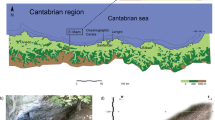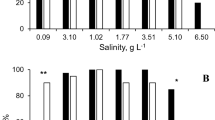Abstract
Seasonal dormancy is a widespread mechanism for reducing energy expenditure during periods of low energy availability. Seasonal variation in activity and the cost of pumping water through the siphons were investigated to estimate the importance of activity regulation to the seasonal energy budget of the Antarctic clam, Laternula elliptica. In the laboratory, a metabolic rate of 26.35 μmol O2 h−1 was estimated for a 50-mm shell length L. elliptica pumping water at −0.4 °C. In the field, the proportion of time siphons were visible at the sediment surface varied seasonally (32% visible in June/July compared to 86% in December/January). L. elliptica were actively pumping for a minimum of 19% of each 24-h period during winter (August) compared to a summer maximum when animals were actively pumping for 73% of the time (February). This resulted in a 3.7-fold seasonal difference in the calculated energy consumption of a 50-mm L. elliptica (19.2 μmol O2 h−1 in February versus 5.0 μmol O2 h−1 in August), which closely matches the 3.0-fold seasonal variation in metabolic rate found previously. Seasonal variation in activity could therefore be responsible for much of the seasonal difference in energy consumption of L. elliptica. Inter-annual variation in timing of the seasonal activity maxima (January 2004 and March 1999) was correlated with variation in the timing of the summer plankton bloom in Ryder Bay. In the laboratory, periods of extended siphon closure (133 ± 114 min, mean ± SD) were accompanied by long periods of heart arrhythmia (167 ± 135 min), during which time blood oxygen levels dropped to values close to zero. Heart arrhythmia is most likely part of a hypo-metabolic adaptation to reduce energy costs during extended periods of siphon closure. Physiological and behavioural dormancy, with associated hypoxia tolerance, appear to be key mechanisms controlling the seasonal energy budget of L. elliptica.






Similar content being viewed by others
References
Bakhmet IN, Khalaman VV (2006) Heart rate variation patterns in some representatives of Bivalvia. Biol Bull 33:276–280
Barnes DKA, Clarke A (1998) Seasonality of polypide recycling and sexual reproduction in some erect Antarctic bryozoans. Mar Biol 131:647–658
Barnes DKA, Peck LS (2005) Extremes of metabolic flexibility in Antarctic bryozoans. Mar Biol 147:979–988
Battey NH (2000) Aspects of seasonality. J Exp Bot 51:1769–1780
van Breukelen F, Martin SL (2002) Molecular biology of thermoregulation–invited review: molecular adaptations in mammalian hibernators: unique adaptations or generalized responses? J Appl Physiol 92:2640–2647
Brockington S (2001) The seasonal energetics of the Antarctic bivalve Laternula eliptica (King and Broderip) at Rothera Point, Adelaide Island. Polar Biol 24:523–530
Brockington S, Peck LS (2001) Seasonality of respiration and ammonium excretion in the Antarctic echinoid Sterechinus neumayeri. Mar Ecol Prog Ser 219:159–168
Boutilier RG, St-Pierre J (2000) Surviving hypoxia without really dying. J Comp Physiol A Mol Integtr Physiol 126:481–490
Buchan P, Peck LS, Tublitz NJ (1988) A light, portable apparatus for the assessment of invertebrate heartbeat rate. J Exp Biol 136:495–498
Buchner T, Abele D, Pörtner HO (2001) Oxyconformity in the intertidal worm Sipunculus nudus: the mitochondrial background and energetic consequences. Comp Biochem Physiol B Biochem Mol Biol 129:109–120
Clarke A (1993) Seasonal acclimatization and latitudinal compensation in metabolism: do they exist? Funct Ecol 7:139–149
Clarke A, Gaston KJ (2006) Climate, energy and diversity. Proc R Soc B 273:2257–2266
Coma R, Ribes M (2003) Seasonal energetic constraints in Mediterranean benthic suspension feeders: effects at different levels of ecological organization. Oikos 101:205–215
Coma R, Ribes M, Gili J-M, Zabala M (2000) Seasonality in coastal benthic ecosystems. Trends Ecol Evol 15:448–453
Fraser KPP, Clarke A, Peck LS (2002) Feast and famine in Antarctica: seasonal physiology in the limpet Nacella concinna. Mar Ecol Prog Ser 242:169–177
Fraser KPP, Peck LS, Clarke A (2004) Protein synthesis, RNA concentrations, nitrogen excretion, and metabolism vary seasonally in the Antarctic holothurian Heterocucumis steineni (Ludwig 1898). Physiol Biochem Zool 77:556–569
Gluck EF, Stephens N, Swoap SJ (2006) Peripheral gherlin deepens torpor boats in mice through the arcuate nucleus neuropeptide Y signaling pathway. Am J Physiol 291:1303–1309
Guppy M, Withers P (1999) Metabolic depression in animals: physiological perspectives and biochemical generalizations. Biol Rev 74:1–40
Hoschscheid S, Bentivegna F, Hays GC (2005) First records of dive durations for a hibernating sea turtle. Biol Lett 1:82–86
Humphries MM, Thomas DW, Kramer DL (2003) The role of energy availability in mammalian hibernation: a cost-benefit approach. Physiol Biochem Zool 76:165–179
Nedergaard J, Cannon B (1990) Mammalian hibernation. Phil Trans R Soc Lond B Biol Sci 326:669–686
Peck LS (1998) Feeding, metabolism and metabolic scope in Antarctic marine ectotherms. In: Pörtner HO, Playle R (eds) Cold ocean physiology. Society for experimental biology seminar series 66. Cambridge University Press, Cambridge, pp 365–390
Peck LS, Barnes DKA, Willmott J (2005) Responses to extreme seasonality in food supply: diet plasticity in Antarctic brachiopods. Mar Biol 147:453–463
Peck LS, Convey P, Barnes DKA (2006) Environmental constraints on life histories in Antarctic ecosystems: tempos, timings and predictability. Biol Rev 81:75–109
Philipp E, Pörtner H-O, Abele D (2005) Mitochondrial ageing of a polar and a temperate mud clam. Mech Ageing Dev 126:610–619
Pörtner HO, Grieshaber MK (1993) Critical Po2(s) in oxyconforming and oxyregulating animals: gas exchange, metabolic rate and the mode of energy production. In: Bicudo JEPW (ed) The vertebrate gas transport cascade: adaptations to environment and mode of life. CRC Press, Boca Raton, FL, pp 330–357
Pörtner HO, Hardewig I, Peck LS (1999) Mitochondrial function and critical temperature in the Antarctic bivalve, Laternula elliptica. Comp Biochem Physiol 124A:179–189
Pörtner HO, Peck LS, Hirse T (2006) Hyperoxia alleviates thermal stress in the Antarctic bivalve, Laternula elliptica: evidence for oxygen limited thermal tolerance. Polar Biol 29:688–693
Tschischka K, Abele D, Pörtner HO (2000) Mitochondrial oxyconformity and cold adaptation in the polychaete Nereis pelagica and the bivalve Arctica islandica from the Baltic and White Seas. J Exp Biol 203:3355–3368
Acknowledgements
We thank Andrew Clarke for useful discussions that improved this manuscript and for providing the Rothera Antarctic Time Series data presented in Fig. 1. We thank the marine and boating teams at Rothera for their support during SCUBA operations in all seasons. Pete Rothery provided excellent statistical advice. These experiments comply with current UK legislation. SAM was funded by the Antarctic Funding Initiative grant 2/34.
Author information
Authors and Affiliations
Corresponding author
Additional information
Communicated by Martin Attrill.
Rights and permissions
About this article
Cite this article
Morley, S.A., Peck, L.S., Miller, A.J. et al. Hypoxia tolerance associated with activity reduction is a key adaptation for Laternula elliptica seasonal energetics. Oecologia 153, 29–36 (2007). https://doi.org/10.1007/s00442-007-0720-4
Received:
Accepted:
Published:
Issue Date:
DOI: https://doi.org/10.1007/s00442-007-0720-4




